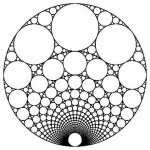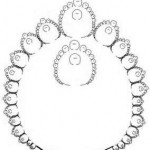 My last post focused on the kinds of problems that can develop when abstract objects, created within mathematics, increase in complexity – like the difficulty of wrapping our heads around them, or of managing them without error. I thought it would be interesting to turn back around and take a look at how the seeds of an idea can vary.
My last post focused on the kinds of problems that can develop when abstract objects, created within mathematics, increase in complexity – like the difficulty of wrapping our heads around them, or of managing them without error. I thought it would be interesting to turn back around and take a look at how the seeds of an idea can vary.
I became aware only recently that a fairly modern mathematical idea was observed in the social organizations of African communities. Ron Eglash, Professor at the Rensselaer Polytechnic Institute, has a multifaceted interest in the intersections of culture, mathematics, science, and technology. Sometime in the 1980’s Eglash made the observation that aerial views of African villages were fractals and he followed this up with visits to the villages to investigate the patterns.
 In a 2007 TED talk Eglash describes the content of the fractal patterns displayed by the villages. One of these villages, located in southern Zambia, is made up of a circular pattern of self-similar rings like the rings shown to the left. The whole village is a ring, and on that ring are the rings of individual families and, within each of those rings are the heads of families. In addition to the repetition of the rings that shape the village and the families, is the repetition of the sacred altar spot. There is a sacred altar placed in the same spot in each individual home. And in each family ring, the home of the head of the family is found in the sacred alter spot. In the ring of all families (or the whole village) the Chief’s ring is in the place of the sacred altar and, within the Chief’s ring, the ring for the Chief’s immediate family are in the place of the sacred altar. Within the home that is the chief’s immediate family, ‘a tiny village’ is in the place of the sacred altar. And within this tiny village live the ancestors. It’s a wonderful picture of an infinitely extending self-similar pattern.
In a 2007 TED talk Eglash describes the content of the fractal patterns displayed by the villages. One of these villages, located in southern Zambia, is made up of a circular pattern of self-similar rings like the rings shown to the left. The whole village is a ring, and on that ring are the rings of individual families and, within each of those rings are the heads of families. In addition to the repetition of the rings that shape the village and the families, is the repetition of the sacred altar spot. There is a sacred altar placed in the same spot in each individual home. And in each family ring, the home of the head of the family is found in the sacred alter spot. In the ring of all families (or the whole village) the Chief’s ring is in the place of the sacred altar and, within the Chief’s ring, the ring for the Chief’s immediate family are in the place of the sacred altar. Within the home that is the chief’s immediate family, ‘a tiny village’ is in the place of the sacred altar. And within this tiny village live the ancestors. It’s a wonderful picture of an infinitely extending self-similar pattern.
Eglash is clear about the fact that these kinds of scaling patterns are not universal to all indigenous architectures, and also that the diversity of African cultures is fully expressed within the fractal technology:
…a widely shared design practice doesn’t necessarily give you a unity of culture — and it definitely is not “in the DNA.”…the fractals have self-similarity — so they’re similar to themselves, but they’re not necessarily similar to each other — you see very different uses for fractals. It’s a shared technology in Africa.
Certainly it is interesting that before the notion of a fractal in mathematics was formalized, purposeful fractal designs were being used by communities in Africa to organize themselves. But what I find even more provocative is that everything in the life of the village is subject to the scaling. Social, mystical, and spatial (geometric) ideas are made to correspond. This says something about the character of the mechanism being used (the fractals), as well as the culture that developed its use.
While it was brief, Eglash did provide a review of some early math ideas on recursive self-similarity, paying particular attention to the Cantor set and the Koch curve. He made the observation that Cantor did see a correspondence between the infinities of mathematics and God’s infinite nature. But in these recursively produced village designs, that correspondence is embodied in the stuff of everyday life. It is as if the ability to represent recursive self-similarity and the facts of life itself are experienced together. The recursive nature of these village designs didn’t happen by accident. It was clearly understood. As Eglash says in his talk,
…they’re mapping the social scaling onto the geometric scaling; it’s a conscious pattern. It is not unconscious like a termite mound fractal.
Given that the development of these patterns happened outside mathematics proper, and predates mathematics’ formal representation of fractals, questions are inevitably raised about what mathematics is and this is exactly the kind of thing on which ethnomathematics focuses. Eglash is an ethnomathematician. A very brief look at the some of the literature in ethnomathematics reveals a fairly broad range of interests, many of which are oriented toward more successful mathematics education, and many of which are strongly criticized. But it seems to me that the meaning and significance of ethnomathematics has not been made precise. In a 2006 paper, Eglash makes an interesting observation. He considers that the “reticence to consider indigenous mathematical knowledge,” may be related to the “Platonic realism of the mathematics subculture.”
For mathematicians in the Euro-American tradition, truth is embedded in an abstract realm, and these transcendental objects are inaccessible outside of a particular symbolic analysis.
Clearly there will be political questions (related to education issues) tied up in this kind of discussion about what and where mathematics is. But, with respect to these African villages, I most enjoyed seeing a mathematical idea become the vehicle with which to explore and represent infinities.


Recent Comments